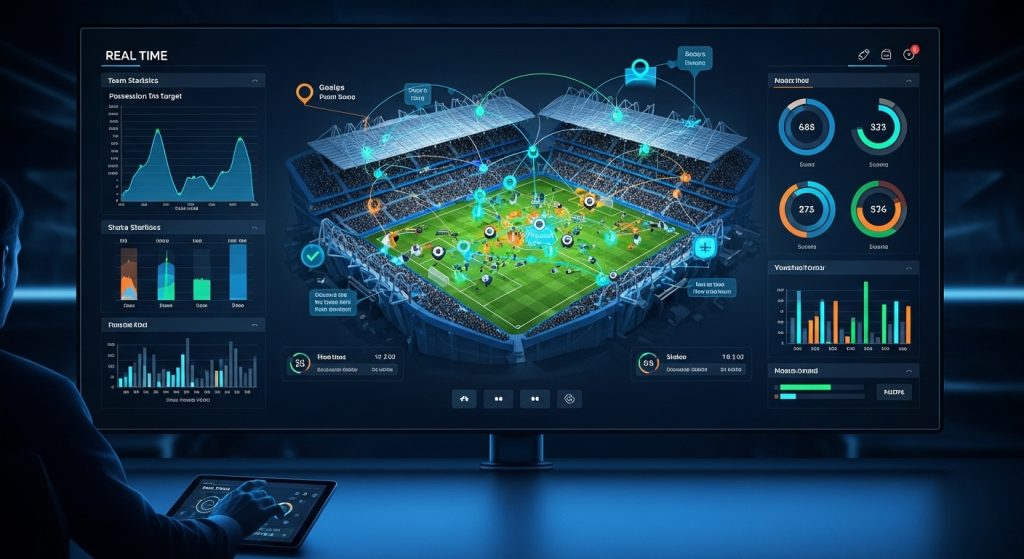
1. Introduction
Data visualization in sports has transformed how performance, strategy, and decision-making are understood. In an era where every movement can be tracked, visualization turns raw data into a narrative — revealing trends, patterns, and tactical truths that numbers alone cannot express. It bridges the gap between data scientists, coaches, and athletes, enabling them to see performance in motion rather than in spreadsheets.
The art of visualization lies not merely in presenting statistics but in communicating insight — converting thousands of events per match into meaningful graphics that drive strategy and innovation.
2. Evolution of Sports Analytics
In the past, performance tracking depended heavily on manual observation and post-game summaries. Coaches took notes, tallied goals or shots, and relied on subjective assessments. The rise of advanced analytics changed this landscape completely.
With wearable technology, optical tracking systems, and AI-assisted video analysis, billions of data points are now collected per season. Data visualization became the language that translates these complex datasets into visual clarity — from heat maps and radar charts to dynamic 3D models.
What began as a support tool has evolved into an essential component of every elite sporting organization. Visualization allows quick comprehension of large datasets, providing both real-time tactical insights and long-term trend evaluations.
3. Core Principles of Visualization
Effective sports visualization is built on three key principles: clarity, context, and comparability.
- Clarity ensures that visual representations are intuitive, avoiding clutter and confusion.
- Context links data points to specific events, time periods, or players, making the information actionable.
- Comparability allows analysts to evaluate differences between athletes, matches, or strategies using consistent metrics.
These principles ensure that visual dashboards communicate performance stories with precision and simplicity, empowering coaches and players to make evidence-based decisions.
4. Common Visualization Tools and Techniques
Modern visualization tools integrate statistical modeling with design sophistication. Among the most common types are:
- Heat Maps: Display player movement density, shot locations, or passing patterns, highlighting activity concentration.
- Radar Charts: Compare multiple attributes — such as speed, stamina, accuracy, and consistency — across players.
- Network Graphs: Represent passing relationships in team sports, revealing central hubs or isolated players.
- Timeline Charts: Track event sequences such as scoring progression, substitutions, or fatigue levels.
- 3D Spatial Models: Visualize player positioning and motion in real-time from multiple camera angles, often using augmented reality overlays.
These tools combine analytical rigor with storytelling power, turning abstract statistics into visual intelligence.
5. Tactical Applications
Coaches and analysts increasingly rely on visualization to design tactics and measure their success.
- Pre-Match Preparation: Opponent analysis charts visualize zones of strength and weakness, helping teams develop counter-strategies.
- In-Game Decision-Making: Real-time dashboards show pressing intensity, passing accuracy, and positional discipline, allowing immediate tactical adjustments.
- Post-Match Review: Visual breakdowns provide insight into transitions, set-piece effectiveness, and player workload, guiding future training plans.
Through these applications, visualization serves as the tactical backbone of modern competition, where every second and every movement can influence the outcome.
6. Performance and Biomechanical Insights
Beyond tactics, visualization is vital for understanding athletic performance and biomechanics.
Motion-tracking sensors capture data on stride length, acceleration, jump height, and joint angles. These data are visualized through motion graphs, skeletal overlays, and velocity curves, enabling coaches to fine-tune movement efficiency while minimizing injury risk.
A sprint coach, for instance, can analyze frame-by-frame velocity maps to adjust a runner’s form; a golf instructor can evaluate swing arcs through layered trajectory diagrams.
By connecting biomechanics to visual feedback, athletes gain instant, intuitive understanding of how technique impacts performance — something numbers alone cannot deliver.
7. Fan Engagement and Media Storytelling
Outside the training ground, visualization has revolutionized how fans experience sports. Broadcasters use augmented graphics, live win probabilities, and possession charts to enhance storytelling during broadcasts.
Fans can explore interactive dashboards that simulate matches, compare players, and predict outcomes using live data feeds.
This democratization of information turns passive spectators into informed participants. The visualization of performance not only deepens understanding but also strengthens emotional connection to the sport.
8. Predictive Modeling and Visualization Integration
The next stage of evolution integrates visualization with predictive analytics. By combining historical data, player statistics, and environmental variables, algorithms can forecast potential outcomes — from injury probability to match results.
Visual dashboards translate these probabilities into comprehensible forms such as probability curves, performance projections, or dynamic trend lines. Coaches and executives can instantly evaluate scenarios like:
- How player fatigue might affect passing efficiency in the final 15 minutes.
- How tactical formations alter goal expectancy.
- How training intensity correlates with peak performance windows.
This synergy between prediction and visualization is redefining competitive preparation and long-term planning.
9. The Role of Artificial Intelligence
Artificial intelligence now drives the most advanced forms of sports visualization. Machine learning models recognize patterns invisible to human analysts, automatically generating visual summaries of trends.
AI-assisted systems can detect recurring tactical behaviors, analyze opponent formations, and even simulate alternative strategies through virtual representation.
For example, an AI-powered visualization engine can show how a team’s press changes spatial structure depending on scoreline or fatigue level.
The integration of AI ensures that visualization evolves from static reporting to dynamic foresight — predicting what might happen next based on current patterns.
10. Challenges and Ethical Considerations
Despite its advantages, data visualization in sports faces key challenges. Excessive data can lead to information overload, diluting critical insights. Misleading visuals, poor scaling, or selective interpretation may distort understanding.
Additionally, privacy and ethics have become major issues, especially concerning biometric tracking and player performance data. Balancing transparency with confidentiality is essential to maintain trust between athletes, teams, and analysts.
Responsible visualization requires not just technical skill but ethical integrity — ensuring that every graphic tells the truth behind the numbers.
11. The Future of Visualization in Sports
The future points toward immersive visualization — the use of virtual reality (VR) and augmented reality (AR) to create interactive 3D environments where data and strategy merge.
Imagine coaches standing inside a virtual field, rewinding plays, and adjusting formations in real time; or athletes viewing their performance from multiple perspectives as holographic simulations.
These advancements will make data interpretation more intuitive, bridging the gap between analysis and experience.
Furthermore, integration with AI-driven storytelling will allow visualizations to explain themselves — automatically highlighting anomalies, correlations, and causal relationships. Visualization will no longer just show what happened, but why it happened, and what is likely to happen next.
12. Conclusion
Data visualization has redefined how sports are analyzed, coached, and consumed. It transforms invisible data streams into visual stories that shape decisions, inspire fans, and elevate performance.
In the modern era, success is not only measured by goals, runs, or points but by the ability to interpret patterns before they occur. Visualization gives shape to knowledge — turning complexity into clarity, motion into meaning, and numbers into narrative.
As technology continues to advance, data visualization will remain the heartbeat of intelligent sport — a fusion of science, creativity, and human understanding that captures both the precision and the poetry of athletic performance.





